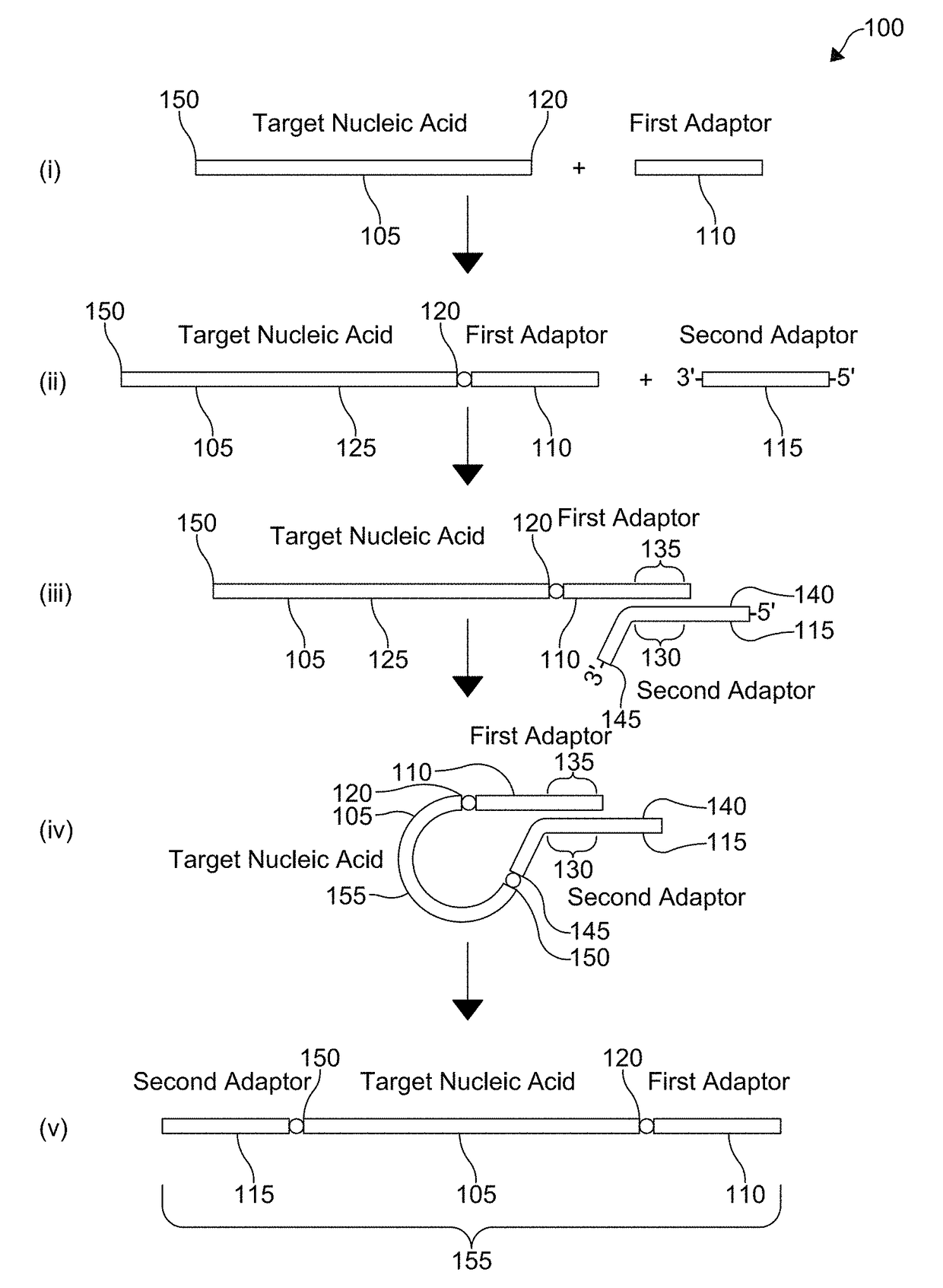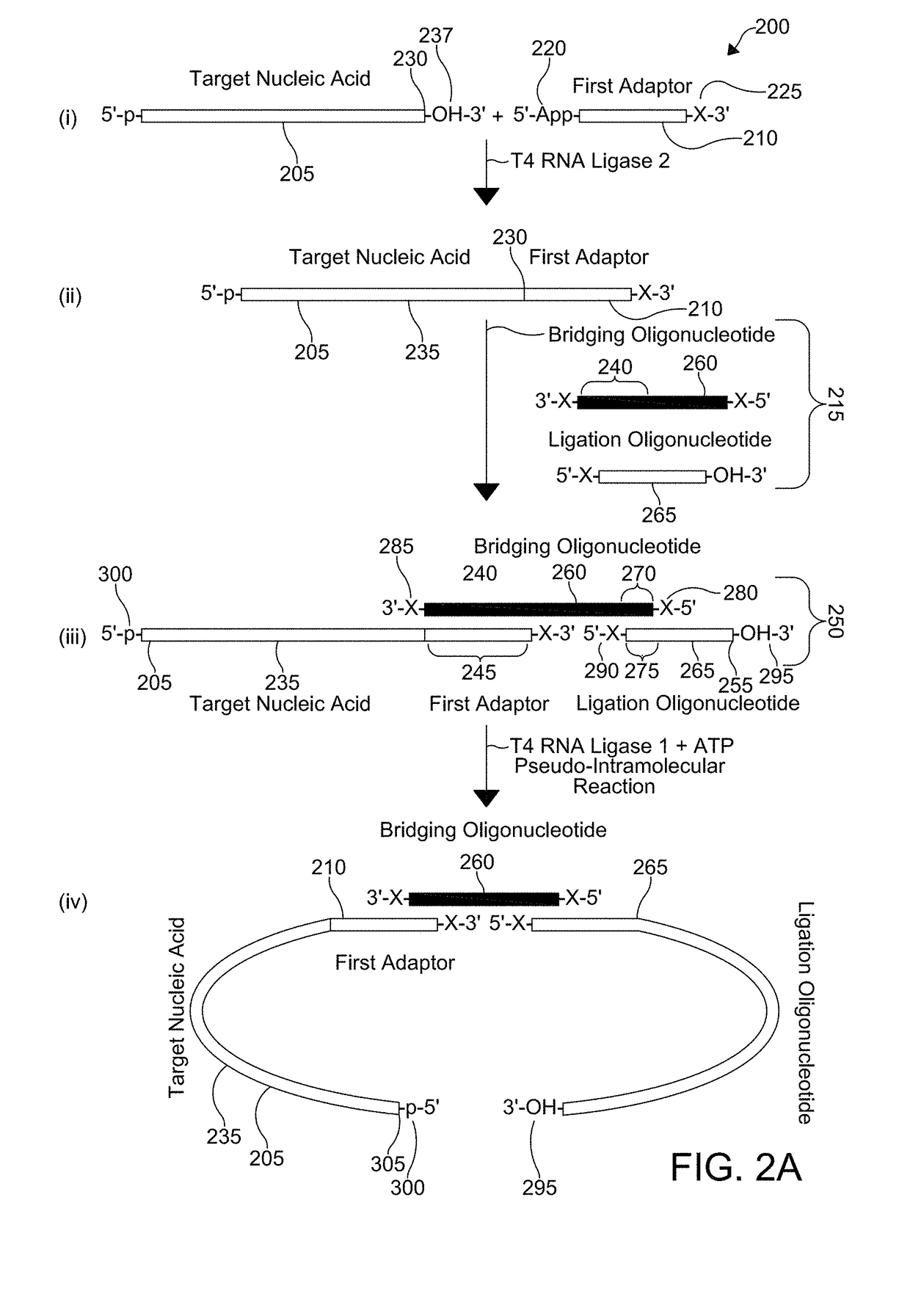Coupling adaptors to a target nucleic acid
a technology of adaptors and nucleic acids, applied in the field of coupling adaptors to a target nucleic acid, can solve the problems of skewing the amplification of the resulting nucleic acid, affecting the representation of individual sequences in the library, and unsatisfactory formation of adapter-dimers
- Summary
- Abstract
- Description
- Claims
- Application Information
AI Technical Summary
Problems solved by technology
Method used
Image
Examples
first embodiment
[0046]With respect to FIG. 1, a flowchart for a method 100 of coupling adaptors to a target nucleic acid 105 is shown. For ease of reference, the method 100 is shown divided into steps (i)-(v), however, it is understood that aspects of certain steps can occur concomitantly with each other or in a different order and the method 100 is not limited to the particular sequential presentation depicted in FIG. 1. The flowchart, moreover, only depicts a single target nucleic acid 105, a single first adaptor 110, and a single second adaptor 115, but it is understood that a plurality of target nucleic acids 105, a plurality of first adaptors 110, and a plurality of second adaptors 115 can be employed, including homogenous or heterogeneous populations of each.
[0047]Step (i) shows the combination of the target nucleic acid 105 with the first adaptor 110. The first adaptor 110 is coupled to a first end 120 of the target nucleic acid 105 to form a coupled first adaptor 125, as shown in step (ii)....
second embodiment
[0051]With respect to FIGS. 2A-2B, a flowchart for a method 200 of coupling adaptors to a target nucleic acid 205 is shown. For ease of reference, the method 200 is shown divided into steps (i)-(vii), however, it is understood that aspects of certain steps can occur concomitantly with each other or in a different order and the method 200 is not limited to the particular sequential presentation depicted in FIGS. 2A-2B. The flowchart, moreover, only depicts a single target nucleic acid 205, a single first adaptor 210, and a single second adaptor 215, but it is understood that a plurality of target nucleic acids 205, a plurality of first adaptors 210, and a plurality of second adaptors 215 can be employed, including homogenous or heterogeneous populations of each.
[0052]Step (i) shows the combination of the target nucleic acid 205 with the first adaptor 210. The first adaptor 210 includes an adenylated 5′-end 220 and a blocked 3′-end 225, where the blocked 3′-end 225 chemically protects...
third embodiment
[0062]With respect to FIGS. 3A-3C, a flowchart for a method 400 of coupling adaptors to a target nucleic acid 405 is shown. For ease of reference, the method 400 is shown divided into steps (i)-(viii), however, it is understood that aspects of certain steps can occur concomitantly with each other or in a different order and the method 400 is not limited to the particular sequential presentation depicted in FIGS. 3A-3C. The flowchart, moreover, only depicts a single target nucleic acid 405, a single first adaptor 410, and a single second adaptor 415, but it is understood that a plurality of target nucleic acids 405, a plurality of first adaptors 410, and a plurality of second adaptors 415 can be employed, including homogenous or heterogeneous populations of each.
[0063]Step (i) shows the combination of the target nucleic acid 405 with the first adaptor 410. The first adaptor 410 includes an adenylated 5′-end 420 and a blocked 3′-end 425, where the blocked 3′-end 425 chemically protect...
PUM
| Property | Measurement | Unit |
|---|---|---|
| weight | aaaaa | aaaaa |
| enzyme activities | aaaaa | aaaaa |
| non-covalent interactions | aaaaa | aaaaa |
Abstract
Description
Claims
Application Information
 Login to view more
Login to view more - R&D Engineer
- R&D Manager
- IP Professional
- Industry Leading Data Capabilities
- Powerful AI technology
- Patent DNA Extraction
Browse by: Latest US Patents, China's latest patents, Technical Efficacy Thesaurus, Application Domain, Technology Topic.
© 2024 PatSnap. All rights reserved.Legal|Privacy policy|Modern Slavery Act Transparency Statement|Sitemap



